
South Asia was once the easternmost part of the Ancient Greek world, an important but little-explored region of the Greek empire and cultural sphere.
The Indian subcontinent is where the Orient meets the Occident and where Sanskrit meets Greek. Where Hinduism, Buddhism, Eastern Orthodoxy and Islam among other faiths have harmoniously come together into a single space.
Ancient Greeks fought the Persians in Thermopylae, but in India both Greeks and Persians lived alongside each other. The Greeks were known as the Yavanas, while the Persians were known as Parsis. Individuals of Yavana ancestry can be found in the regions of Himachal Pradesh and Kashmir, and there are large pockets of Parsis living in the Mumbai financial capital. They follow Zoroastrianism, the faith of the Persian kings Xerxes and Darius.
The journey begins from the northernmost outpost of a Greek-influenced region in South Asia. From Gandhara of Pakistan to Kashmir of India, one may travel to Madhya Pradesh and Maharashtra. There we find sites associated with Ancient Greek Hinduism and Buddhism.
In Sri Lanka, one can explore the beaches and visit the ancient capital of Anuradhapura, which was once settled by Greeks.
Upon exploring South Asia, the Greek influence becomes apparent. While the Byzantines were the protector of Christendom, Indo-Greek rulers were the protectors of Buddhism.
Sirkap, South Asia, and its Ancient Greek king
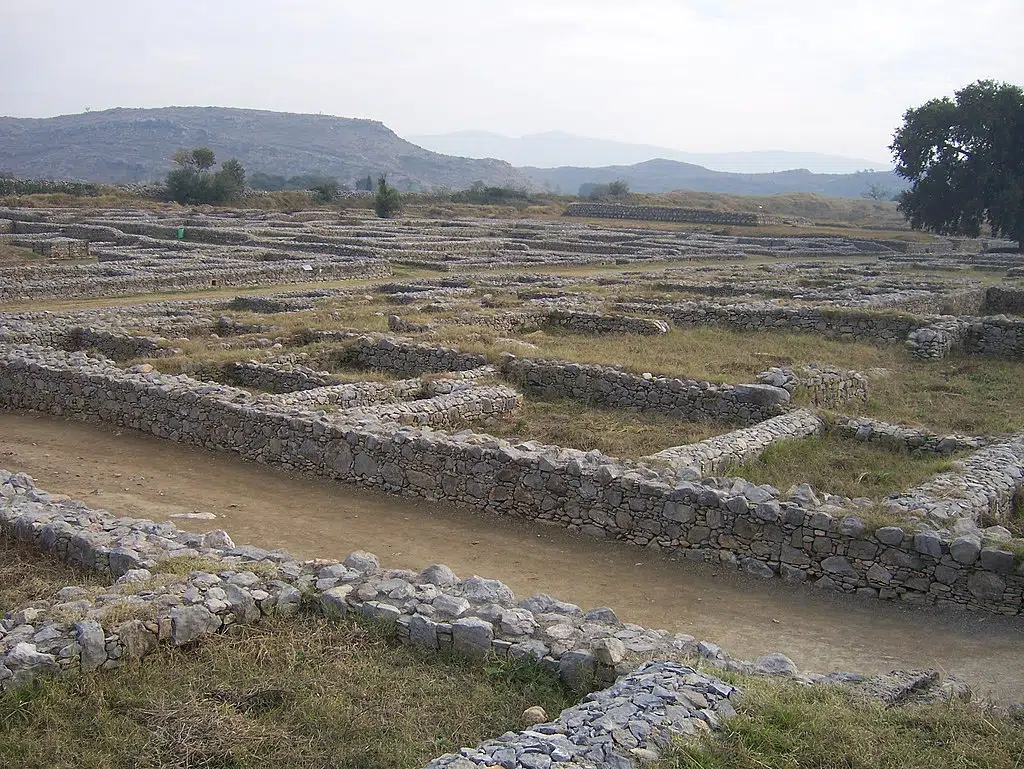
Sirkap in modern day Pakistan was discovered by Alexander Cunningham in 1863 and explored and excavated by John Marshall between 1913 and 1930. Marshall was director general of the Archaeological Survey of India while still under British rule. Sirkap was founded by Greek King Demetrius around 180 BC after conquering the region and making it the second most significant city of the region after Taxila.
The city was rebuilt by Greek King Menander around 44 AD. He drew a parallel between the planning of Sirkap and that of Athens during his travels. Menander described Sirkap as being the size of Nineveh, the then capital of Assyria. The Oldest Jain Temple of Pakistan is in fact located there.
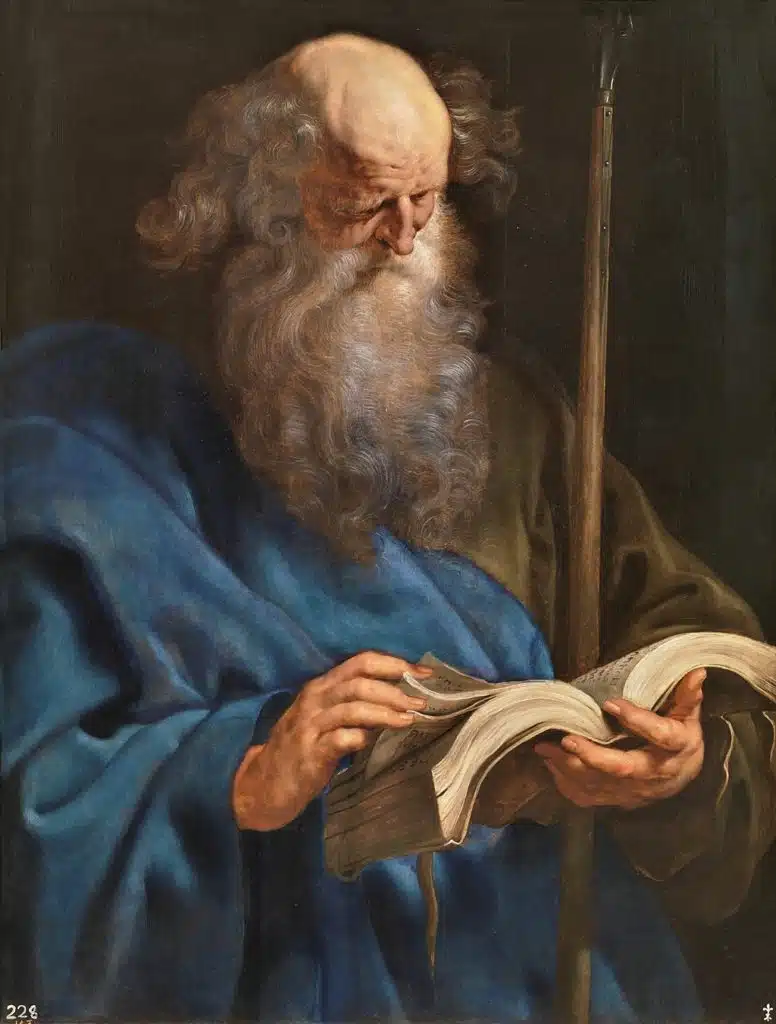
According to the Acts of Thomas, which was written in Syriac by an anonymous writer in the third century CE, the Christian apostle Saint Thomas arrived in Sirkap in 40 CE and found himself in the service of the Indo-Parthian king Gondophores. In 1935, a farmer tilling a field outside the ruins found a cross which was later presented to the Anglican Bishop of Lahore.
The famous Taxila Cross is now housed at the Cathedral Church of the Resurrection in Punjab’s capital city. Sirkap is also a major pilgrimage site for Pakistani Christians.
Kashmir

Much like Sirkap, Kashmir, which lies in the northernmost corner of the South Asian subcontinent was once part of the ancient Greek kingdom. Alexander Cunningham wrote of the ancient Kashmir temple’s architecture in a detailed article titled “An Essay on the Arian Order of Architecture as Exhibited in Temples of Kashmir.”
Herein, he wrote that: “The architectural remains are perhaps the most remarkable of the existing monuments of India and they exhibit undoubted traces of the influence of Grecian art.”
He further added that they “cannot, indeed, [be viewed] with the severe simplicity of the Parthenon nor with the luxuriant gracefulness of the monument of Lysicrates, but they possess great beauty, different indeed, yet quite their own.”

As per scholar Iqbal Ahmad “one enters these ruined complexes, it feels as if you are walking through the lanes of ancient Greece and Rome.” These ruins are located in the lower and upper Jhelum Valley of Kashmir Bunyar in Uri, up to Martand in Anantnag.
The most remarkable of these structures include the stone-formed monuments at Bunyar, Rampur, Pattan, Prahaspura, Takhta, Suliman, Pandrathan, Avantipura and Martand.
Madhya Pradesh
The world famous Sanchi Stupa, which is now a UNESCO world heritage site, also had Greeks who funded its construction. Three inscriptions are known from Indo-Greek donors at Sanchi, the clearest of which reads: “Gift of the Greek of Setapatha.” Setapatha is likely an undetermined city.
Temple 18 is a Chaitya, or prayer hall, and bears a striking resemblance to classical Greek columned buildings. Dating back to the seventh century, the temple originally had twelve pillars, nine of which remain standing. The temple lies on a raised platform facing the southern gateway of the Sanchi Stupa.
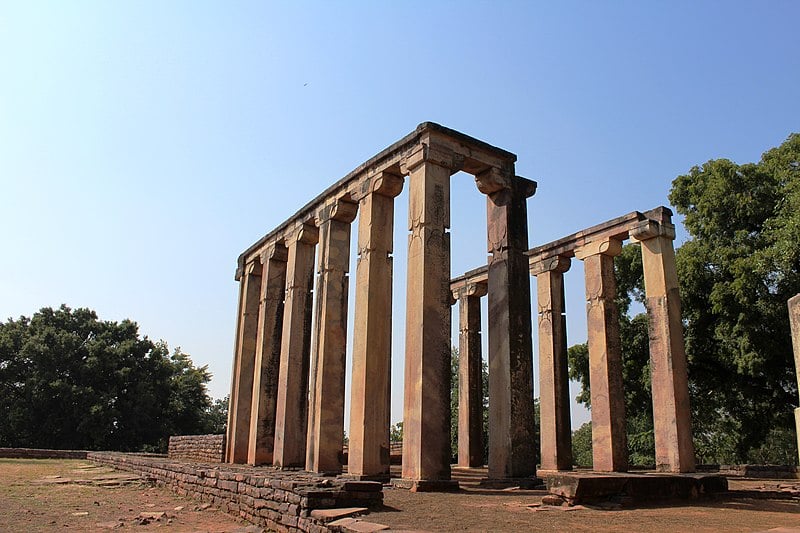
A Garuda Pillar, worshipped by fisherman in Besnagar in the city of Vidisha, contains an inscription that vindicates the conversion of a Greek person to Hinduism. The inscription reads: “This Garuda-standard of Vasudeva, the god of gods, was constructed here by Heliodora (Heliodoros), the Bhagavata, son of Dion, a man of Takhkhasila (Taxila), the Greek ambassador who came from the Great King, Amtalikita (Antialkidas) to King Kasiputra Bhagabhadra, the Saviour, prospering in (his) fourteenth regnal year.”
The second inscription on the pillar, in the same script as the first, recites a verse from the Hindu epic Mahabharata. According to the Mahabharata, there are three requirements—control, generosity, and attention—for immortality. When correctly followed, these lead to heaven.
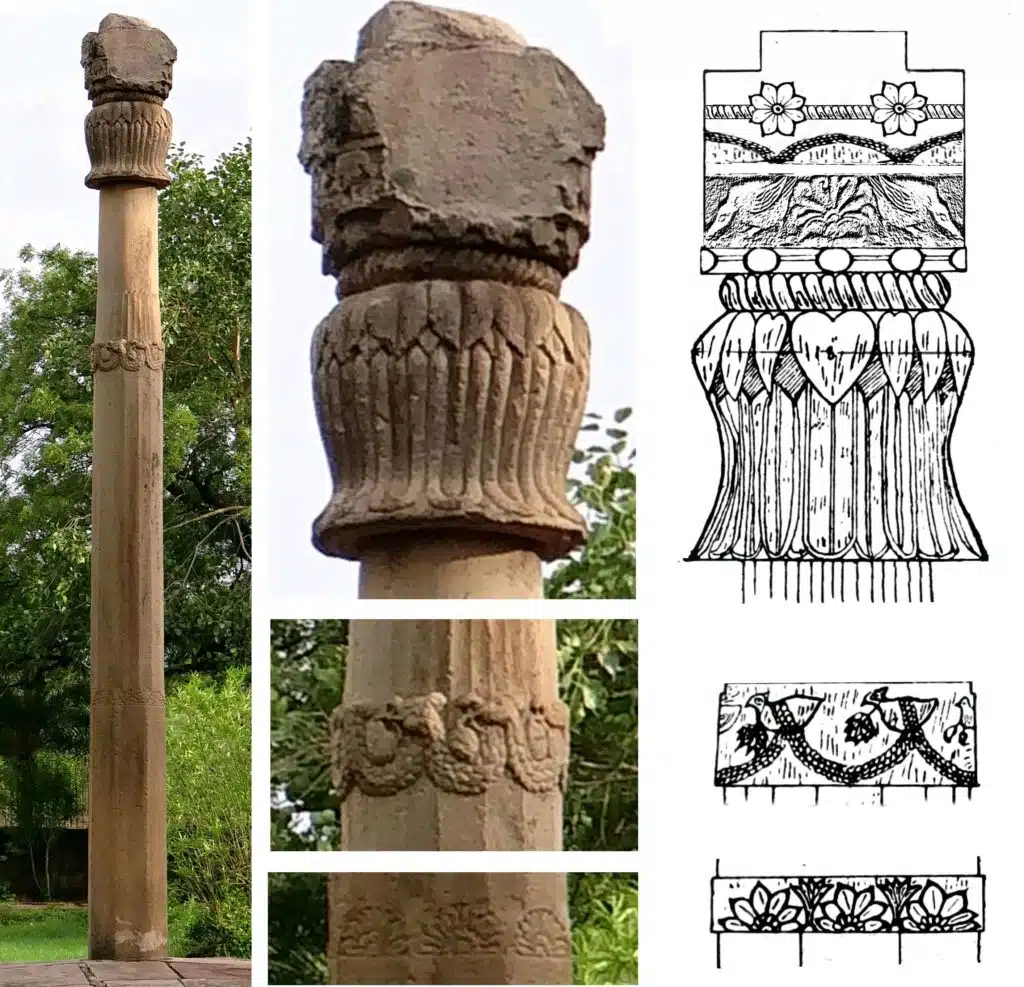
Maharashtra
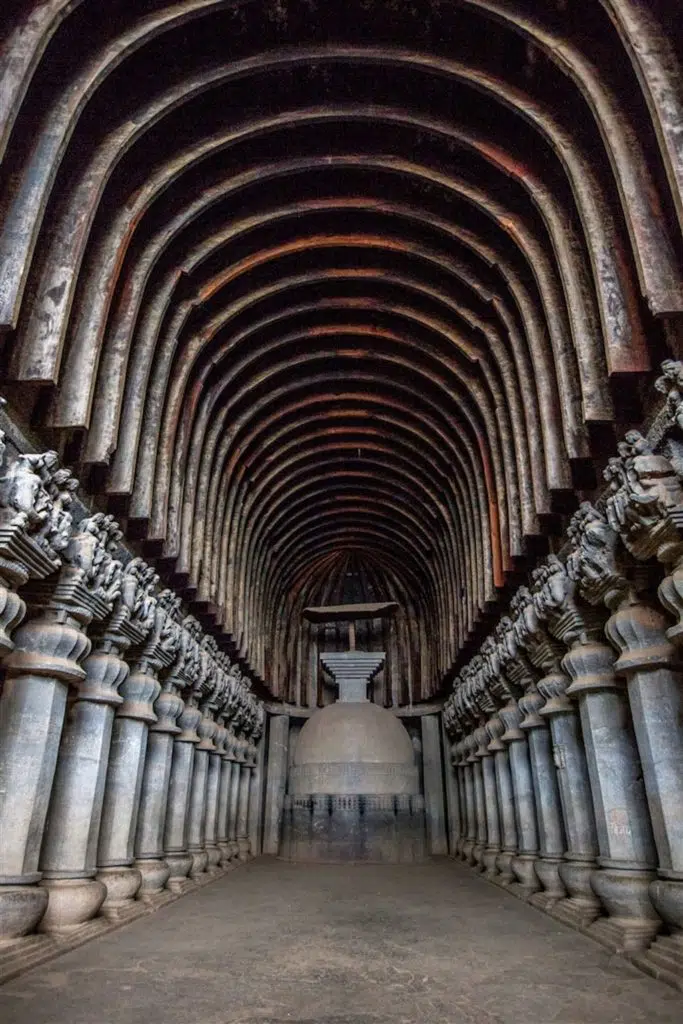
The ancient Greeks were not able to establish their rule by military conquests over Maharashtra since native rulers such as the Satvahanas stood strong. However, as patrons of Buddhism, the Greeks did have a significant impact on religion, architecture, and art in Maharashtra. The Pali chronicles state that at the conclusion of the third Buddhist Council, organized under the patronage of Emperor Asoka, Buddhist missions were sent to various parts of India and Ceylon.
It is also mentioned that a Greek Yonarakkhita was sent to Northern Konkan, in what is now Maharashtra, for spreading Buddhist faith. In the famous UNESCO world heritage site of Ajanta, the murals are painted in what would go on to become a style distinct to the Indian subcontinent. With elements such as the use of perspective, lime mortar, and the three quarter profiles of the figures, it suggests Ancient Greek influence.
A Buddhist Monastery, or Vihara, in Nashik in Maharashtra, was made by the donations of a Greek man, as incripted in Cave 17. At the Yavana Vihara of the Nashik Caves, the inscription found reads as follows: “Success! (The gift) of Indragnidatta, son of Dhammadeva, the Yavana, a northerner from Dattamittri.
By him, inspired by true religion, this cave has been caused to be excavated in mount Tiranhu, and inside the cave a Chaitya (Buddhist Temple) and cisterns. This cave made for the sake of his father and mother has been, in order to honour all Buddhas bestowed on the universal Samgha by monks together with his son Dhammarakhita.” Inscription No. 18, in Cave No, 17.
The inscriptions describing the donations by the Greeks, account for nearly half of the known dedicatory inscriptions on the pillars of the Chaitya (Buddhist Temple) of Karla caves in Maharashtra. These inscriptions are found on the 3rd pillar of the left row, the 4th pillar of the left row, the 9th pillar of the left row, the 5th pillar of the right row, the 13th pillar of the right row, and 15th pillar of the right row. Next to the inscription is a Buddhist Swastika.
An inscription mentioning Greek donations for construction is found in Shivneri Caves, too. It states: “Donation of two tanks by the Yavana Irila, in the name of the Gatas”, and “Gift of a refectory for the community (Sangha) from Cita the Yavana, on behalf of the Gatas.” In the Manmodi caves, the façade of the Chaitya Hall was donated by a Greek, as inscripted on the central flat surface of the lotus.
Anuradhapura
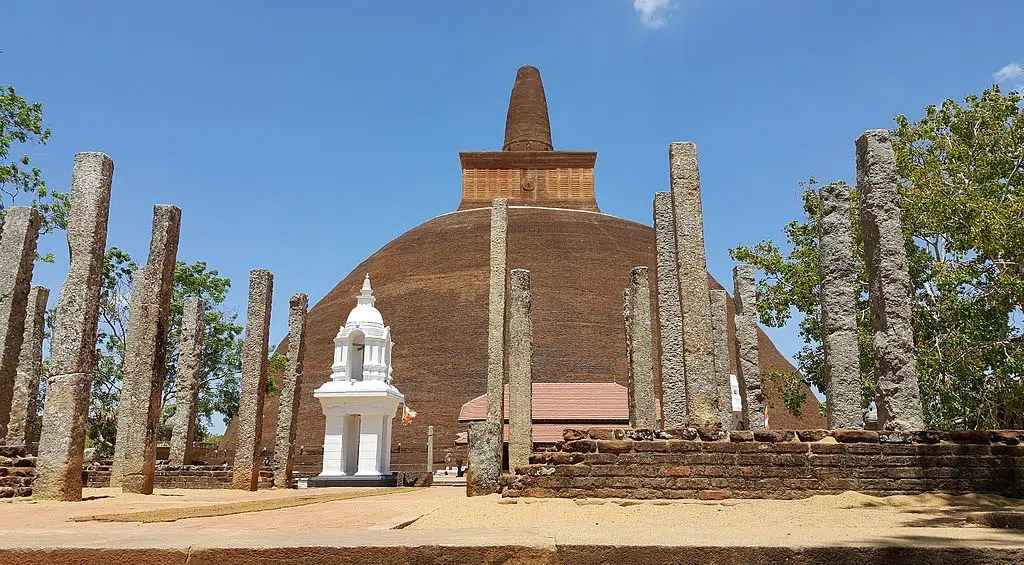
Buddhist text Mahavamsa mentions that King Pandukabhaya built a great city where Anuradha Gama was located. He named it “Anuradhapura” and made it the capital city of Sri Lanka. He set apart grounds for the Yona near the west gate of Anuradhapura.
That is the first known visit of Greeks to Sri Lanka. Explaining the set up of the Greek settlement as a strategic move by king Pandukabhaya, one of Sri Lanka’s greatest classists, professor Merlin Peris, quotes fro,m D.P.M. Weerakkody’s “Taprobane: Ancient Sri Lanka as known to the Greeks and the Romans”:
“The establishment of a foreign quarter in the Capital at this early date implies a very prompt reaction on the part of Sri Lanka to the new conditions brought about by Greek penetration into North West India after Alexander the Great and an equally prompt penetration by the Greeks into regions further afield.”
The second visit by Greeks came several centuries later at the time of King of Sri Lanka Dutugemunu. Almost 30,000 Greek Buddhist monks arrived to celebrate the completion of the Mahathupa (Buddhist Temple). Mahavamsa refers to a delegation of Greek Buddhist monks who arrived from “Alasanda” in Anuradhapura to participate in the inauguration ceremony of the building of the Mahathupa (Buddhist Temple).
It should be known that professor Merlin Peris, agreeing with Geiger, says that the Alexandria referred herein is near Kabul. The Mahavamsa also makes the point that the Greeks were among the earliest people, other than the Indians, to convert to Buddhism, even earlier than the people of Sri Lanka.
It is also known that Greek Buddhist monks headed missions as Greek was used for the spread of the Dhamma among the Greeks of India as well as in the neighbouring regions but also to the West. It is likely that classical Greek may have been spoken in a small part of the island of Sri Lanka, not far from the West Gate of Anuradhapura.
See all the latest news from Greece and the world at Greekreporter.com. Contact our newsroom to report an update or send your story, photos and videos. Follow GR on Google News and subscribe here to our daily email!



